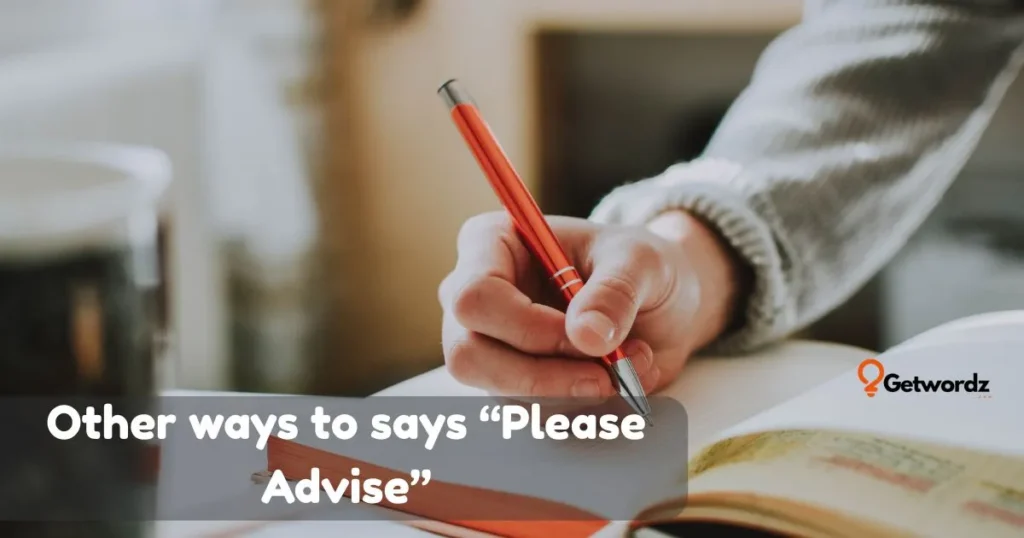Please Advise is a common phrase we often use in emails, messages, or casual conversations when we need guidance, feedback, or a little direction.
While it’s simple and polite, relying on it too much can make your communication feel repetitive, bland, or even overly formal.
Whether you’re asking a colleague for input, seeking advice from a friend, or checking with a partner about a decision, finding fresh ways to express the same request can make your message more engaging and personal.
In this post, we’ve curated a variety of creative alternatives, better wording options, and unique expressions to replace “please advise,” ensuring your communication stands out while still remaining professional or friendly.
From funny responses to polished, professional phrasing, these options are perfect for emails, texts, or verbal exchanges across all kinds of scenarios.
If you’ve ever wondered how to sound more authentic, approachable, or clear when asking for guidance, this guide is packed with practical, relatable examples that will inspire you. Keep reading to discover the best ways to say please advise without sounding repetitive or robotic.
1. Could You Guide Me?
Scenario: You’re unsure how to proceed with a client request and need guidance from a colleague.
Explanation: This professional and polite alternative conveys a collaborative tone and shows respect for the recipient’s knowledge. It’s a creative way to replace the often overused “please advise.”
Examples:
- Could you guide me on how to complete this report?
- I’m unsure of the next steps. Could you guide me?
- Could you guide me through the approval process?
Why It Works:
It demonstrates humility and willingness to learn, encouraging detailed guidance while maintaining professionalism.
2. I Would Appreciate Your Input
Scenario: Preparing a presentation and wanting feedback from your manager.
Explanation: Formal yet warm, this phrasing emphasizes valuing the recipient’s opinion. It’s a better way to ask for advice without sounding repetitive.
Examples:
- I would appreciate your input on the draft.
- Your feedback is important; I would appreciate your input.
- I would appreciate your input before finalizing the document.
Why It Works:
This expression signals respect, encourages thoughtful feedback, and is versatile for formal or semi-formal contexts.
3. Your Thoughts Would Be Helpful
Scenario: Planning a team event and needing colleagues’ opinions.
Explanation: Casual but professional, it softens the request while showing openness to collaboration.
Examples:
- Your thoughts would be helpful regarding the schedule.
- I’d love to hear your thoughts. They would be helpful.
- Your thoughts would be helpful on this project plan.
Why It Works:
It invites input without pressure, making it approachable and collaborative.
4. Could You Offer Advice?
Scenario: Seeking recommendations from a mentor on career decisions.
Explanation: Slightly formal, this alternative highlights seeking expert guidance and is a unique expression that feels respectful.
Examples:
- Could you offer advice on handling this client?
- I’m unsure how to proceed. Could you offer advice?
- Could you offer advice on improving the process?
Why It Works:
It positions the recipient as an expert and encourages thoughtful, considered feedback.
5. I’m Seeking Your Guidance
Scenario: Deciding on a strategic plan and asking a senior colleague for input.
Explanation: Formal and respectful, this phrase emphasizes sincerity and professional courtesy.
Examples:
- I’m seeking your guidance on our next steps.
- I’m seeking your guidance for this project decision.
- I’m seeking your guidance before submitting the proposal.
Why It Works:
It conveys professionalism and trust, showing that you value informed advice.
Read more: 30 Other Ways To Say “Safe Travels” With Examples!
6. What Do You Recommend?
Scenario: Choosing a tool or approach and asking a coworker for suggestions.
Explanation: Direct and casual, this phrase encourages practical recommendations in a friendly tone.
Examples:
- What do you recommend for managing this project?
- I’m unsure which software to choose. What do you recommend?
- What do you recommend to streamline our workflow?
Why It Works:
It’s concise, approachable, and actionable, making it versatile across contexts.
7. Any Suggestions?
Scenario: Planning an informal outing with friends.
Explanation: Friendly and conversational, this alternative invites participation without sounding formal.
Examples:
- Any suggestions for dinner spots?
- Any suggestions for improving this draft?
- Any suggestions for weekend activities?
Why It Works:
Encourages engagement and collaboration while keeping a relaxed tone.
8. Could You Share Your Opinion?
Scenario: Sending a draft design to a colleague for review.
Explanation: Personal and polite, this alternative values the recipient’s perspective over a generic request.
Examples:
- Could you share your opinion on this layout?
- I’d like to hear your perspective. Could you share your opinion?
- Could you share your opinion regarding the plan?
Why It Works:
Shows respect and openness, making it ideal for both professional and casual scenarios.
9. I’d Love Your Advice
Scenario: Asking a friend for personal guidance on a decision.
Explanation: Warm and approachable, this phrase is less formal than “please advise” and creates a genuine tone.
Examples:
- I’d love your advice on choosing a course.
- I’d love your advice for planning the event.
- I’d love your advice on handling this situation.
Why It Works:
It feels personal and sincere, encouraging honest and thoughtful input.
10. Looking Forward to Your Guidance
Scenario: Submitting a report and awaiting managerial feedback.
Explanation: Professional and courteous, signaling anticipation of constructive advice.
Examples:
- Looking forward to your guidance on the project.
- I’m looking forward to your guidance regarding the next steps.
- Looking forward to your guidance on resolving this issue.
Why It Works:
Shows respect and readiness to act, ideal for formal communication.
Read more: 30 Other Ways To Say “Sorry For Your Loss” With Examples!
11. Can You Advise Me?
Scenario: Unsure about the next steps in a team task.
Explanation: Short, direct, and professional, this alternative works well in emails or messages.
Examples:
- Can you advise me on the next steps?
- I’m not sure how to proceed. Can you advise me?
- Can you advise me regarding client communication?
Why It Works:
Clear, professional, and straightforward, suitable for a wide range of formal and informal contexts.
12. Seeking Your Expertise
Scenario: Asking a consultant for technical guidance.
Explanation: Highlights respect for knowledge and experience, making it an authoritative alternative.
Examples:
- I’m seeking your expertise on this issue.
- Seeking your expertise to improve project outcomes.
- Your expertise is invaluable. I’m seeking your guidance.
Why It Works:
Emphasizes trust, professionalism, and encourages detailed, informed responses.
13. Your Insight Would Help
Scenario: Collaborating on a project with team members.
Explanation: Professional but approachable, this phrase invites thoughtful contribution.
Examples:
- Your insight would help clarify our next steps.
- I’d value your insight on this plan.
- Your insight would help avoid potential issues.
Why It Works:
Encourages collaboration while making the recipient feel valued.
14. Please Recommend
Scenario: Asking a supplier for product suggestions.
Explanation: Polite and actionable, it’s a clear alternative to “please advise.”
Examples:
- Please recommend the best software for small businesses.
- Could you please recommend a reliable vendor?
- Please recommend adjustments for the plan.
Why It Works:
Concise and effective, suitable for professional communication that requires clear guidance.
15. Would You Mind Sharing Your Thoughts?
Scenario: Requesting feedback on a presentation.
Explanation: Polite, conversational, and respectful of the recipient’s time.
Examples:
- Would you mind sharing your thoughts on this draft?
- I’d appreciate it if you could share your thoughts.
- Would you mind sharing your thoughts on the proposal?
Why It Works:
Encourages open feedback without sounding demanding or formal.
Read more: 30 Other Ways To Say “The End In a Story” With Examples!
16. Hoping for Your Guidance
Scenario: Seeking advice from a mentor before making a major decision.
Explanation: Formal, respectful, and emphasizes anticipation of helpful feedback.
Examples:
- Hoping for your guidance on the strategic plan.
- I’m hoping for your guidance before finalizing the project.
- Hoping for your guidance to ensure accuracy.
Why It Works:
Shows deference and professionalism, perfect for senior-level communications.
17. I Value Your Opinion
Scenario: Discussing a creative idea with a team member.
Explanation: Polite and sincere, emphasizing the importance of the recipient’s perspective.
Examples:
- I value your opinion on this concept.
- Your input matters. I value your opinion.
- I value your opinion before we proceed.
Why It Works:
Builds trust and encourages honest feedback, great for collaborative settings.
18. What’s Your Take?
Scenario: Asking a friend or colleague for a quick opinion.
Explanation: Casual, conversational, and approachable, ideal for quick feedback.
Examples:
- What’s your take on this design?
- I’m unsure what you take?
- What’s your take on the schedule?
Why It Works:
Makes requests feel conversational and friendly, perfect for informal contexts.
19. Could You Point Me in the Right Direction?
Scenario: Asking someone for guidance on navigating a complex task.
Explanation: Informal yet polite, suggesting assistance without imposing.
Examples:
- Could you point me in the right direction for this report?
- I’m lost. Could you point me in the right direction?
- Could you point me in the right direction regarding next steps?
Why It Works:
Shows humility and openness, making it versatile across professional and casual situations.
20. Can I Get Your Feedback?
Scenario: Requesting thoughts on a draft or idea from a peer.
Explanation: Slightly casual, suitable for collaborative settings, and a simple alternative to “please advise.”
Examples:
- Can I get your feedback on this presentation?
- I’d appreciate it if I could get your feedback.
- Can I get your feedback regarding the draft?
Why It Works:
Encourages interaction and discussion, ideal for team projects or creative work.
Read more: 30 Other Ways To Say “Happy Married Life” With Examples!
21. Would Appreciate Your Thoughts
Scenario: Seeking advice from a mentor or senior colleague.
Explanation: Polite and professional, emphasizing the value of input.
Examples:
- Would appreciate your thoughts on the strategy.
- I would appreciate your thoughts on the next steps.
- Would appreciate your thoughts before finalizing.
Why It Works:
Shows respect for experience and encourages constructive feedback.
22. I Need Your Perspective
Scenario: Asking a trusted colleague or friend to weigh in on a decision.
Explanation: Emphasizes the value of someone’s unique viewpoint, making it a strong alternative.
Examples:
- I need your perspective on this client issue.
- I need your perspective before moving forward.
- Could I get your perspective on the proposal?
Why It Works:
Highlights trust and collaboration, making it excellent for professional and personal use.
23. Help Me Decide
Scenario: Choosing between two options and seeking input.
Explanation: Friendly and straightforward, inviting advice without pressure.
Examples:
- Help me decide which design works best.
- Could you help me decide on the next steps?
- Help me decide if this approach is suitable.
Why It Works:
Casual, approachable, and action-oriented, making decision-making collaborative.
24. Your Counsel Is Needed
Scenario: Reaching out to an expert for formal guidance.
Explanation: Formal and respectful, ideal for legal, financial, or professional advice.
Examples:
- Your counsel is needed regarding this contract.
- I would like your counsel on this strategic plan.
- Your counsel is needed before proceeding.
Why It Works:
Signals respect, expertise, and seriousness, suitable for high-stakes requests.
25. Guidance Requested
Scenario: Sending a formal email to a superior or authority figure.
Explanation: Professional, neutral, and concise, perfect for official correspondence.
Examples:
- Guidance requested on the project proposal.
- Guidance requested before submitting the final draft.
- Guidance requested regarding next steps in the process.
Why It Works:
Clear, formal, and authoritative, meeting professional standards.
26. I’d Appreciate Your Direction
Scenario: Seeking advice from a manager or mentor.
Explanation: Polite and respectful, emphasizing reliance on the recipient’s expertise.
Examples:
- I’d appreciate your direction on handling this matter.
- I’d appreciate your direction before moving forward.
- I’d appreciate your direction regarding the plan.
Why It Works:
Shows professionalism, clarity, and respect for the recipient’s experience.
27. Would You Kindly Advise?
Scenario: Formal email or letter requesting input.
Explanation: Polished, courteous, and professional alternative to “please advise.”
Examples:
- Would you kindly advise on the next steps?
- Would you kindly advise regarding this matter?
- Would you kindly advise on the best approach?
Why It Works:
Extremely respectful and formal, suitable for senior-level communication.
28. Can You Suggest Next Steps?
Scenario: Emailing a supervisor or team lead after completing a task.
Explanation: Direct, action-oriented, and professional, making it a practical alternative.
Examples:
- Can you suggest next steps for this project?
- I’ve completed the draft. Can you suggest next steps?
- Can you suggest next steps regarding the approval process?
Why It Works:
Focused on actionable guidance, clear, and professional, ideal for workplace communication.
29. Looking Forward to Your Recommendations
Scenario: Wrapping up a proposal and asking for final input from a manager.
Explanation: Professional, courteous, and polite, emphasizing anticipation of guidance.
Examples:
- Looking forward to your recommendations on this project.
- I’m looking forward to your recommendations regarding improvements.
- Looking forward to your recommendations before final submission.
Why It Works:
Signals respect, readiness to act, and encourages detailed feedback in formal settings.
30. Requesting Your Expertise
Scenario: Consulting a senior or specialist for an important decision.
Explanation: Highlights the recipient’s authority and knowledge, making it an ideal professional alternative.
Examples:
- Requesting your expertise on the new policy changes.
- Requesting your expertise to finalize this plan.
- Requesting your expertise regarding the client presentation.
Why It Works:
Shows deference and professionalism while making the request clear and actionable, perfect for formal communication.
Pros and cons of Using “Please Advise”
pros
- Polite and Professional: Signals respect when requesting guidance or feedback in formal communications.
- Concise: Short, easy to type, and universally understood in business contexts.
- Versatile: Can be used in emails, letters, or messaging platforms across industries.
- Signals Action Needed: Clearly indicates that a response or direction is expected.
- Widely Recognized: Most English-speaking professionals understand its meaning instantly.
Cons
- Overused: Can feel repetitive or generic, lacking personal touch.
- Vague: Doesn’t specify exactly what guidance is needed, which may confuse the recipient.
- Can Sound Demanding: In certain contexts, it may come across as abrupt or impatient.
- Lacks Warmth: Doesn’t convey collaboration or engagement like alternatives do.
- Less Modern: Some newer business communications prefer more conversational or action-oriented phrasing.
Closing words
Please Advise doesn’t have to feel repetitive or bland. This post explored fresh alternatives, creative expressions, and better wording that help you communicate requests more clearly and personally. By using these options, you can avoid overused phrasing and make your messages more engaging.
Whether you’re reaching out to colleagues for professional guidance, asking friends for input, or posting on social media, these unique expressions and creative alternatives offer different ways to say the same thing with authenticity.
Try one of these phrases in your next message and notice how it opens up conversation naturally. Using these fresh wordings improves clarity, thoughtfulness, and impact, making your communication feel intentional and meaningful.
Next time you need advice, embrace these please advise alternatives to create messages that truly resonate and feel personal.




